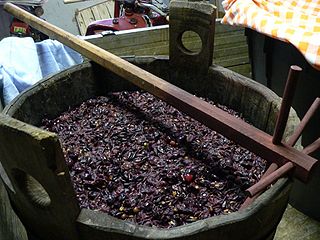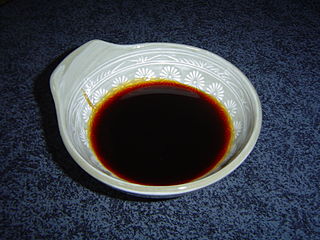
Pekmez (Turkish : pekmez) is a molasses-like syrup obtained after condensing juices of fruit must, especially grape by boiling it with a coagulant agent like wood ashes or ground carob seeds. It is used as a syrup or mixed with tahini for breakfast.

Pekmez (Turkish : pekmez) is a molasses-like syrup obtained after condensing juices of fruit must, especially grape by boiling it with a coagulant agent like wood ashes or ground carob seeds. It is used as a syrup or mixed with tahini for breakfast.
Pekmez is etymologically Oghuz Turkic in origin and it was called bekmes in the past. The oldest written account of the word is recorded in 1073 dictionary Dīwān Lughāt al-Turk by Mahmud al-Kashgari. [1] [2]
Fruit molasses, defrutum, goes back to the classical period. [3]
During the Byzantine era, the region of Trapezus (modern Trebizond) grew mulberry trees for silkworms. Local Armenians used mulberries to make a sweet syrup called petmez or pekmez; the Greeks made grape syrup, siraios (σιραίος). After the Byzantine Empire fell, the term petmez replaced the Greek names for grape syrup in Greek, in the form petimezi.[ citation needed ]
In Turkey, sugar beet (şeker pancarı), figs (incir) or mulberry (dut) are often used, as well as juniper berries (andiz). Pekmez made from carob (keçiboynuz or harnup) is popularly recommended as a treatment for iron deficiency anemia. [4] [5] In Azerbaijan, pekmez is made mostly from mulberry, grape, rosehip (doshab) or pomegranates(narsharab).
In the Balkans, it is more jam-like in texture and usually made of plums. It usually contains more fruit products and less sugar than jam. [6] In Greece, it is called petimezi (πετιμέζι).
In Arab cuisine, dibs or dibis (in some regions called "robb" or "rubb") is made from pomegranates, grapes, carob, [7] or dates. [3]

Molasses is a viscous substance, principally obtained from the refining of sugarcane or sugar beet juice into sugar. Molasses varies in the amount of sugar, the method of extraction and the age of the plant. Sugarcane molasses is usually used to sweeten and flavour foods. Molasses is a major constituent of fine commercial brown sugar. It is also one of the main ingredients used to distill rum.

The pomegranate is a fruit-bearing deciduous shrub in the family Lythraceae, subfamily Punicoideae, that grows between 5 and 10 m tall. The pomegranate is rich in symbolic and mythological associations in many cultures.

Tahini or tahina is a Levantine condiment made from toasted ground hulled sesame. It is served by itself or as a major ingredient in hummus, baba ghanoush, and halva.

The carob is a flowering evergreen tree or shrub in the Caesalpinioideae sub-family of the legume family, Fabaceae. It is widely cultivated for its edible fruit, which takes the form of seed pods, and as an ornamental tree in gardens and landscapes. The carob tree is native to the Mediterranean region and the Middle East. Portugal is the largest producer of carob, followed by Italy and Morocco.

Must is freshly crushed fruit juice that contains the skins, seeds, and stems of the fruit. The solid portion of the must is called pomace and typically makes up 7–23% of the total weight of the must. Making must is the first step in winemaking. Because of its high glucose content, typically between 10 and 15%, must is also used as a sweetener in a variety of cuisines. Unlike commercially sold grape juice, which is filtered and pasteurized, must is thick with particulate matter, opaque, and comes in various shades of brown and purple.

Dolma is a family of stuffed dishes associated with Turkish or Ottoman cuisine, typically made with a filling of rice, minced meat, offal, seafood, fruit, or any combination of these inside a vegetable or a leaf wrapping. Wrapped dolma, specifically, are known as sarma, made by rolling grape, cabbage, or other leaves around the filling. Dolma can be served warm or at room temperature and are common in modern cuisines of regions and nations that once were part of the Ottoman Empire.

Jallab or Jellab is a type of fruit syrup popular in the Middle East made from carob, dates, grape molasses and rose water. Jallab is very popular in Palestine, Syria, Jordan, Lebanon and Egypt. It is made mainly of grape molasses, grenadine syrup, and rose water, then smoked with Arabic incense. It is usually sold with crushed ice and floating pine nuts and raisins.

Iraqi cuisine is a Middle Eastern cuisine that has its origins in the ancient Near East culture of the fertile crescent. Tablets found in ancient ruins in Iraq show recipes prepared in the temples during religious festivals—the first cookbooks in the world. Ancient Mesopotamia was home to a sophisticated and highly advanced civilization, in all fields of knowledge, including the culinary arts.

Spoon sweets are sweet preserves, served in a spoon as a gesture of hospitality in Bosnia, Serbia, Albania, Greece, Turkey, Kosovo, Cyprus, the Balkans, parts of the Middle East, and Russia. They can be made from almost any fruit, though sour and bitter fruits are especially prized. There are also spoon sweets produced without fruit.

Fruit syrups or fruit molasses are concentrated fruit juices used as sweeteners.

Churchkhela is a traditional Georgian candle-shaped candy.

Date honey, date syrup, date molasses, Debes, or rub is a thick dark brown, very sweet fruit syrup extracted from dates. It is widely used in Middle Eastern cuisine and Maghrebi cuisine.

Vincotto is a dark, sweet, thick paste produced in rural areas of Italy. It is made by the slow cooking and reduction over many hours of non-fermented grape must until it has been reduced to about one-fifth of its original volume and the sugars present have caramelized. It can be made from a number of varieties of local red wine grapes, including Primitivo, Negroamaro and Malvasia Nera, and before the grapes are picked they are allowed to wither naturally on the vine for about thirty days. In Roman times it was known as sapa in Latin and epsima in Greek, the same names that are often used for it in Italy and Cyprus, respectively, today.

Grape syrup is a condiment made with concentrated grape juice. It is thick and sweet because of its high ratio of sugar to water. Grape syrup is made by boiling grapes, removing their skins, squeezing them through a sieve to extract the juice. Like other fruit syrups, a common use of grape syrup is as a topping to sweet cakes, such as pancakes or waffles.
Nevzine dessert is a Turkish dessert made with tahini, pekmez and walnut. It is a regional specialty of Kayseri province. It is usually served on Ramadan and on holidays.

Sharbat is a drink prepared from fruit or flower petals. It is a sweet cordial, and usually served chilled. It can be served in concentrated form and eaten with a spoon or diluted with water to create the drink.
{{cite web}}: CS1 maint: numeric names: authors list (link)